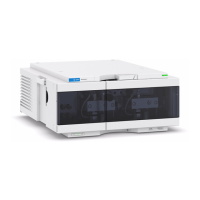1290 Infinity II High-Speed Pumps User Manual 62
3Using the Pump
Solvent Recommendation for Agilent 1290 Infinity and 1290 Infinity II and 1260
Infinity II Flexible Pumps
• Use a minimum flow rate of 5 µL/min or 1 % composition per solvent channel
(whatever is greater) to avoid cross-flow. Cross-flow can be caused by micro
leaks in pump heads and can result in buffer precipitation in pump heads,
channel blocking, or reduced pump head life time through wear of seals and
pistons.
• Consider using an inline filter, for example Inline filter (G1311-60006).
• Never leave buffers in a system without flow. Before shutting down a system,
flush it extensively with warm water to avoid clogging of valves, capillaries, or
flow cells or reducing the life time of your column. If the system is not used
for some time, for example more than a day depending on lab temperature, fill
all solvent lines with organic solvent or water with at least 10 % isopropanol.
• Regularly maintain the LC system.
Handling of Acetonitrile
Acetonitrile is a solvent that is frequently used in reversed-phase
chromatography. Despite of its common use, it can be a source of issues if not
handled correctly.
As Acetonitrile ages, some residue can get stuck on internal pump surfaces
which can cause issues with valve performance and therefore affect retention
time precision.
When using acetonitrile:
• Use high-quality solvents from renowned suppliers.
• Use fresh solvents and filter them.
• Minimize exposure to light and air/oxygen.
• Choose a bottle size which fits to your application and usage.
• Acids accelerate solvent aging. If possible avoid such additives or refresh
solvents more frequently.
• Pure acetonitrile ages faster. If your application allows, add about 5 % water
and adjust gradient compositions.
• Do not leave acetonitrile in unused systems to avoid aging. If not in use, flush
all solvent lines with a mixture of water and 10 % isopropanol.
• In case of blocked valves, flush the system with hot water. Knock at valves,
flush them (see “Release a Stuck Inlet Valve” on page 158) or ultrasonicate
them, for example in methanol.

